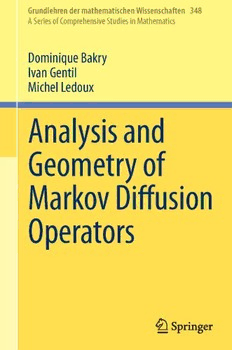
Analysis and geometry of Markov diffusion operators PDF
Preview Analysis and geometry of Markov diffusion operators
Grundlehren der mathematischen Wissenschaften 348 ASeriesofComprehensiveStudiesinMathematics Serieseditors M.Berger P.delaHarpe N.J. Hitchin A.Kupiainen G.Lebeau F.-H.Lin S.Mori B.C.Ngô M. Ratner D.Serre N.J.A. Sloane A.M. Vershik M.Waldschmidt Editor-in-Chief A.Chenciner J.Coates S.R.S.Varadhan Forfurthervolumes: www.springer.com/series/138 Dominique Bakry (cid:2) Ivan Gentil (cid:2) Michel Ledoux Analysis and Geometry of Markov Diffusion Operators DominiqueBakry MichelLedoux InstitutdeMathématiquesdeToulouse InstitutdeMathématiquesdeToulouse UniversitédeToulouse UniversitédeToulouse andInstitutUniversitairedeFrance andInstitutUniversitairedeFrance Toulouse,France Toulouse,France IvanGentil InstitutCamilleJordan UniversitéClaudeBernardLyon1 Villeurbanne,France ISSN0072-7830 ISSN2196-9701(electronic) GrundlehrendermathematischenWissenschaften ISBN978-3-319-00226-2 ISBN978-3-319-00227-9(eBook) DOI10.1007/978-3-319-00227-9 SpringerChamHeidelbergNewYorkDordrechtLondon LibraryofCongressControlNumber:2013952461 MathematicsSubjectClassification: 39B62,39B72,47D07,53C21 ©SpringerInternationalPublishingSwitzerland2014 Thisworkissubjecttocopyright.AllrightsarereservedbythePublisher,whetherthewholeorpartof thematerialisconcerned,specificallytherightsoftranslation,reprinting,reuseofillustrations,recitation, broadcasting,reproductiononmicrofilmsorinanyotherphysicalway,andtransmissionorinformation storageandretrieval,electronicadaptation,computersoftware,orbysimilarordissimilarmethodology nowknownorhereafterdeveloped.Exemptedfromthislegalreservationarebriefexcerptsinconnection with reviews or scholarly analysis or material supplied specifically for the purpose of being entered and executed on a computer system, for exclusive use by the purchaser of the work. Duplication of this publication or parts thereof is permitted only under the provisions of the Copyright Law of the Publisher’slocation,initscurrentversion,andpermissionforusemustalwaysbeobtainedfromSpringer. PermissionsforusemaybeobtainedthroughRightsLinkattheCopyrightClearanceCenter.Violations areliabletoprosecutionundertherespectiveCopyrightLaw. Theuseofgeneraldescriptivenames,registerednames,trademarks,servicemarks,etc.inthispublication doesnotimply,evenintheabsenceofaspecificstatement,thatsuchnamesareexemptfromtherelevant protectivelawsandregulationsandthereforefreeforgeneraluse. Whiletheadviceandinformationinthisbookarebelievedtobetrueandaccurateatthedateofpub- lication,neithertheauthorsnortheeditorsnorthepublishercanacceptanylegalresponsibilityforany errorsoromissionsthatmaybemade.Thepublishermakesnowarranty,expressorimplied,withrespect tothematerialcontainedherein. Printedonacid-freepaper SpringerispartofSpringerScience+BusinessMedia(www.springer.com) HowfarcanyougowiththeCauchy-Schwarz inequalityandintegrationbyparts? To Leonard Gross Preface SemigroupsofoperatorsonaBanachspaceprovideverygeneralmodelsandtools in the analysis of time evolution phenomena and dynamical systems. They have a long history in mathematics and have been studied in a number of settings, from functionalanalysisandmathematicalphysicstoprobabilitytheory,Riemanniange- ometry,Liegroups,analysisofalgorithms,andelsewhere. The part of semigroup theory investigated in this book deals with Markov dif- fusionsemigroupsandtheirinfinitesimalgenerators,whichnaturallyariseassolu- tionsofstochasticdifferentialequationsandpartialdifferentialequations.Assuch, the topic covers a large body of mathematics ranging from probability theory and partialdifferentialequationstofunctionalanalysisanddifferentialgeometryforop- eratorsorprocessesonmanifolds.Withintheseframeworks,researchinterestshave grown over the years, now encompassing a wide variety of questions such as reg- ularity and smoothing properties of differential operators, Sobolev-type estimates, heatkernelbounds,non-explosionproperties,convergencetoequilibrium,existence andregularityofsolutionsofstochasticdifferentialequations,martingaleproblems, stochasticcalculusofvariationsandsoon. Thisbookismorepreciselyfocusedontheconcreteinterplaybetweentheana- lytic,probabilisticandgeometricaspectsofMarkovdiffusionsemigroupsandgen- eratorsinvolvedinconvergencetoequilibrium,spectralbounds,functionalinequal- ities and various bounds on solutions of evolution equations linked to geometric propertiesoftheunderlyingstructure. Oneprototypicalexampleatthisinterfaceissimplythestandardheatsemigroup (Pt)t≥0 ontheEuclideanspaceRn whoseGaussiankernel 1 u=u(t,x)=p (x)= e−|x|2/4t, t>0, x∈Rn, t (4πt)n/2 isafundamentalsolutionoftheheatequation ∂ u=(cid:4)u, u(0,x)=δ , t 0 forthestandardLaplaceoperator(cid:4),thuscharacterizedastheinfinitesimalgenerator ofthesemigroup(Pt)t≥0. vii viii Preface From the probabilistic viewpoint, the family of kernels p (x), t >0, x ∈Rn, t representsthetransitionprobabilitiesofastandardBrownianmotion(Bt)t≥0 as (cid:4) (cid:2) (cid:3) E f(x+B ) = f(y)p (x−y)dy=P f(x), t>0, x∈Rn, 2t t t Rn forallboundedmeasurablefunctionsf :Rn→R. Thethirdaspectinvestigatedinthisworkisgeometric,andperhapslessimme- diately apparent than the analytic and probabilistic aspects. It aims to interpret, in somesense,thecommutationofderivationandactionofthesemigroupasacurva- turecondition.ForthestandardEuclideansemigroupexampleabove,thecommu- tation∇P f =P (∇f)willexpressazerocurvature,althoughthiscorrespondsnot t t onlytothecurvatureofEuclideanspaceasaRiemannianmanifoldbutrathertothe curvatureofEuclideanspaceequippedwiththeLebesguemeasure,invariantunder theheatflow(Pt)t≥0,andthebilinearoperator(cid:6)(f,g)=∇f ·∇g. Inordertocarryouttheinvestigationalongtheselines,theexpositionemphasizes thebasicstructureofaMarkovTriple1 (E,μ,(cid:6))consistingofa(measurable)state spaceE,acarréduchampoperator(cid:6)andameasureμinvariantunderthedynamics inducedby(cid:6).Thenotionofacarréduchampoperator(cid:6)associatedwithaMarkov semigroup(Pt)t≥0 withinfinitesimalgeneratorLgiven(onasuitablealgebraAof functionsonE)by (cid:5) (cid:6) 1 (cid:6)(f,g)= L(fg)−fLg−gLf , 2 willbeacentraltoolofinvestigation,theassociated (cid:6)-calculusproviding,atleast at a formal level, a kind of algebraic framework encircling the relevant properties andresults. Theseanalytic,stochasticandgeometricfeaturesformthebasisoftheinvestiga- tionundertakeninthisbook,describingMarkovsemigroupsviatheirinfinitesimal generatorsassolutionsofsecondorderdifferentialoperatorsandtheirprobabilistic representationsasMarkovprocesses,andanalyzingthemwithrespecttocurvature properties. The investigation is limited to symmetric (reversible in the Markovian terminology) semigroups, although various ideas and techniques go beyond this framework. We also restrict our attention to the diffusion setting, that is when the carréduchampoperatorisaderivationoperatorinitstwoarguments,eveninthose caseswheretheresultcouldbeextendedtoamoregeneralsetting.Theserestrictions ruleoutmanyinterestingfieldsofapplications(discreteMarkovchains,modelsof statisticalmechanics,mostoftheanalysisofalgorithmsofinterestinoptimization theory or approximations of partial differential equations, for example), but allow ustoconcentrateoncentralfeaturesintheanalysisofsemigroups,inthesameway thatordinarydifferentialequationsareingeneraleasiertohandlethandiscretese- quences.Evenwithinthefieldofsymmetricdiffusionsemigroups,wehavenottried 1Theterminology“Markovtriple”shouldnot,ofcourse,beconfusedwithsolutionsoftheMarkov Diophantineequationx2+y2+z2=3xyz! Preface ix tocoverallthepossibleinterestingcases.Inordertokeepthemonographwithina reasonablesize,wehavehadtoomit,amongotherthings,thespecificanalysisre- lated to hypoelliptic diffusions, special features of diffusions on Lie groups, and manyinterestingdevelopmentsarisingfrominfiniteinteractingparticlesystems. Inaddition,althoughwehavelargelybeenmotivatedbytheanalysisofthebe- haviorofdiffusionprocesses(thatis,solutionsoftimehomogeneousstochasticdif- ferential equations), rather than concentrating on the probabilistic aspects of the subject,suchasalmostsureconvergenceoffunctionalsofthetrajectoriesoftheun- derlyingMarkovprocesses,recurrenceortransience,weinsteadchosetotranslate most of the features of interest into functional analytic properties of the Markov structure(E,μ,(cid:6))underinvestigation. Heatkernelbounds,functionalinequalitiesandtheirapplicationstoconvergence to equilibrium and geometric features of Markov operators are among the main topicsofinterestdevelopedinthismonograph.Aparticularemphasisisplacedon familiesofinequalitiesrelating,onaMarkovTriple(E,μ,(cid:6)),functionalsoffunc- tionsf :E→Rtotheenergyinducedbytheinvariantmeasureμandthecarrédu champoperator(cid:6), (cid:4) E(f,f)= (cid:6)(f,f)dμ. E Typicalfunctionalsarethevariance,entropyorLp-normsleadingtothemainfunc- tionalinequalitiesofinterest,thePoincaréorspectralgapinequality,thelogarithmic SobolevinequalityandtheSobolevinequality.Aparticulargoalistoestablishsuch familiesofinequalitiesundersuitablecurvatureconditionswhichmaybedescribed bythecarréduchampoperator(cid:6)anditsiterated(cid:6) operator. 2 Similar inequalities are investigated at the level of the underlying semigroup (Pt)t≥0 for the heat kernel measures, comparing Pt(ϕ(f)) (for some ϕ :R→R) to P ((cid:6)(f,f)) or (cid:6)(P f,P f), which give rise to heat kernel bounds. With this t t t taskinmind,wewilldevelopthemainpowerfultoolofheatflowmonotonicity,or semigroupinterpolation,withnumerousillustrativeapplicationsandstrongintuitive content.Toillustratetheprinciple,asawinktowardswhatistocome,letusbriefly presenthereaheatflowproofoftheclassicalHölderinequalitywhichisverymuch in the spirit of this book. In particular, the reduction to a quadratic bound is typi- caloftheargumentsdevelopedinthiswork.Let f,g besuitable(strictly)positive functionsonRn andθ ∈(0,1).Forfixedt>0,consider,atanypoint(omitted),the interpolation (cid:2) (cid:3) (cid:9)(s)=P eθlogPt−sf+(1−θ)logPt−sg , s∈[0,t], s where (Pt)t≥0 is the standard heat semigroup on Rn as recalled above. Together withtheheatequation∂ P =(cid:4)P =P (cid:4),thederivativeins of(cid:9)isgivenby s s s s (cid:2) (cid:2) (cid:3) (cid:5) (cid:2) (cid:3) (cid:2) (cid:3)(cid:6)(cid:3) (cid:9)(cid:6)(s)=P (cid:4) eH −eH θe−F(cid:4) eF +(1−θ)e−G(cid:4) eG s x Preface where F =logPt−sf, G=logPt−sg and H =θF +(1−θ)G.Nowbystandard calculus, (cid:2) (cid:3) (cid:5) (cid:2) (cid:3) (cid:2) (cid:3)(cid:6) e−H(cid:4) eH − θe−F(cid:4) eF +(1−θ)e−G(cid:4) eG =|∇H|2−θ|∇F|2−(1−θ)|∇G|2 which is negative by convexity of the square function. Hence (cid:9)(s), s ∈[0,t], is decreasing,andthus (cid:2) (cid:3) (cid:9)(t)=P fθg1−θ ≤(P f)θ(P g)1−θ =(cid:9)(0). t t t Normalizingbytn/2 andlettingt tendtoinfinityyieldsHölder’sinequalityforthe Lebesgue measure. Actually, the same argument may be performed at the level of a Markov semigroup with invariant finite discrete measure, thus yielding Hölder’s inequalityforarbitrarymeasures. Whilefunctionalinequalitiesandtheirrelatedapplicationsareanimportantfocal point, they also give us the opportunity to discuss a number of issues related to examples and properties of Markov semigroups and operators. One objective of thisworkisthusalsotopresentthebasictoolsandideasrevolvingaroundMarkov semigroupsandtoillustratetheirusefulnessindifferentcontexts. Themonographcomprisesthreemainparts. The first part, covering Chaps. 1 to 3, presents some of the main features, properties and examples of Markov diffusion semigroups and operators as con- sidered in this work. In a somewhat informal but intuitive way, Chap. 1 intro- duces Markov semigroups, their infinitesimal generators and associated Markov processes, stochastic differential equations and diffusion semigroups. It also de- scribes a few of the standard operations and techniques while working with semi- groups. Chapter 2 develops in detail a number of central geometric models which will serve as references for later developments, namely the heat semigroups and LaplaciansontheflatEuclideanspace,thesphereandthehyperbolicspace.Sturm- Liouvilleoperatorsontheline,andsomeofthemostrelevantexamples(Ornstein- Uhlenbeck,LaguerreandJacobi),arealsopresentedtherein.Onthebasisofthese preliminary observations and examples, Chap. 3 then tries to describe a general framework of investigation. While it would not be appropriate to try to cover in a uniqueformalmouldallthecasesofinterest,itisneverthelessusefultoemphasize thebasicpropertiesandtoolsinordertoeasilyandsuitablydevelopthe(cid:6)-calculus. In particular,it is necessaryto describewithsomecare thevarious classes andal- gebras of functions that we shall be dealing with and to show their relevance in theclassicalsmoothsettings.Notethatwhileinfinite-dimensionalmodelswouldre- quirefurthercareinthisabstractformalism,themethodsandprinciplesemphasized throughoutthisworkaresimilarlyrelevantforthem.Takingthemoreclassicalpic- tureasgranted,Chap.3maybeskippedatfirstreading(orlimitedtothesummary Sect.3.4). PartII,formingthecoreofthetext,includesChaps.4to6andcoversthethree mainfunctionalinequalitiesofinterest,Poincaréorspectralgapinequalities,loga- rithmicSobolevinequalitiesandSobolevinequalities.Foreachfamily,somebasic
